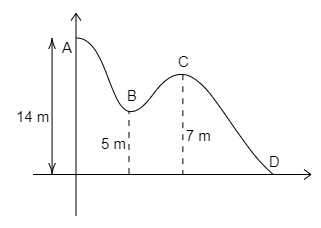Answer
64.8k+ views
Hint: In this question it is given that the mass of the block is at some height after some time it is released from one position after releasing the block and gets one position. So that the kinetic energy of the required position is equal to the potential energy of the initial position, which is given by the law of conservation of energy.
Useful formula
The law of conservation of energy shows that the energy in a system are equal, then
$KE = PE$
Where, $KE$ is the kinetic energy of the block and $PE$ is the potential energy of the block.
The potential energy of the block is given by,
$PE = mgh$
Where, $PE$ is the potential energy of the block, $m$ is the mass of the block, $g$ is the acceleration due to gravity on the block and $h$ is the height of the block.
Complete step by step solution
Given that,
The mass of the block is, $m = 2\,kg$,
The height of the block at the position of $A$ is, ${h_A} = 14\,m$,
The height of the block at the position of $C$ is, ${h_C} = 7\,m$.
Now,
The law of conservation of energy shows that the energy in a system are equal, then
$KE = PE\,.......................\left( 1 \right)$
The potential energy of the block is given by,
$PE = mgh\,...................\left( 2 \right)$
Now substituting the mass of the block, acceleration of the block due to gravity and the height between the position $A$ and the position $C$ in the above equation (2), then
$PE = 2 \times 10 \times \left( {14 - 7} \right)$
Here, the acceleration due to gravity is taken as $10\,m{s^{ - 2}}$ and the height of the block between the position $A$ and the position $C$, the height value is taken from the graph.
Now subtracting the terms in the above equation, then
$PE = 2 \times 10 \times 7$
By multiplying the terms in the above equation, then
$PE = 140\,J$
By substituting the above equation in the equation (1), then
$KE = PE = 140\,J$
Thus, the above equation shows the kinetic energy as the block reaches the position $C$.
Hence, the option (B) is the correct answer.
Note The energy can neither be created nor destroyed. The energy can be transferred from one form to another form. In this question, the block is kept in some height, so that the block will have the potential energy, when the block is released, the potential energy of the block is changed to the kinetic energy of the block, this statement is given by law of conservation of the energy.
Useful formula
The law of conservation of energy shows that the energy in a system are equal, then
$KE = PE$
Where, $KE$ is the kinetic energy of the block and $PE$ is the potential energy of the block.
The potential energy of the block is given by,
$PE = mgh$
Where, $PE$ is the potential energy of the block, $m$ is the mass of the block, $g$ is the acceleration due to gravity on the block and $h$ is the height of the block.
Complete step by step solution
Given that,
The mass of the block is, $m = 2\,kg$,
The height of the block at the position of $A$ is, ${h_A} = 14\,m$,
The height of the block at the position of $C$ is, ${h_C} = 7\,m$.
Now,
The law of conservation of energy shows that the energy in a system are equal, then
$KE = PE\,.......................\left( 1 \right)$
The potential energy of the block is given by,
$PE = mgh\,...................\left( 2 \right)$
Now substituting the mass of the block, acceleration of the block due to gravity and the height between the position $A$ and the position $C$ in the above equation (2), then
$PE = 2 \times 10 \times \left( {14 - 7} \right)$
Here, the acceleration due to gravity is taken as $10\,m{s^{ - 2}}$ and the height of the block between the position $A$ and the position $C$, the height value is taken from the graph.
Now subtracting the terms in the above equation, then
$PE = 2 \times 10 \times 7$
By multiplying the terms in the above equation, then
$PE = 140\,J$
By substituting the above equation in the equation (1), then
$KE = PE = 140\,J$
Thus, the above equation shows the kinetic energy as the block reaches the position $C$.
Hence, the option (B) is the correct answer.
Note The energy can neither be created nor destroyed. The energy can be transferred from one form to another form. In this question, the block is kept in some height, so that the block will have the potential energy, when the block is released, the potential energy of the block is changed to the kinetic energy of the block, this statement is given by law of conservation of the energy.
Recently Updated Pages
Write a composition in approximately 450 500 words class 10 english JEE_Main

Arrange the sentences P Q R between S1 and S5 such class 10 english JEE_Main

What is the common property of the oxides CONO and class 10 chemistry JEE_Main

What happens when dilute hydrochloric acid is added class 10 chemistry JEE_Main

If four points A63B 35C4 2 and Dx3x are given in such class 10 maths JEE_Main

The area of square inscribed in a circle of diameter class 10 maths JEE_Main

Other Pages
Excluding stoppages the speed of a bus is 54 kmph and class 11 maths JEE_Main

In the ground state an element has 13 electrons in class 11 chemistry JEE_Main

Electric field due to uniformly charged sphere class 12 physics JEE_Main

A boat takes 2 hours to go 8 km and come back to a class 11 physics JEE_Main

According to classical free electron theory A There class 11 physics JEE_Main

Differentiate between homogeneous and heterogeneous class 12 chemistry JEE_Main




